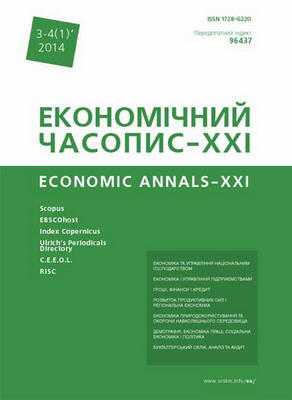ОЦІНКА МЕТОДІВ НАРАХУВАННЯ АМОРТИЗАЦІЇ В КОНТЕКСТІ СТИМУЛЮВАННЯ ІНВЕСТИЦІЙНОЇ АКТИВНОСТІ
ASSESSMENT OF DEPRECIATION METHODS WITHIN THE INVESTMENT ACTIVITY PROMOTION
Author(s): Yurii Myskin, Oksana MyskinaSubject(s): Economy
Published by: Institute of Society Transformation
Keywords: amortization; depreciation methods; tax incentives; investment activity
Summary/Abstract: Problem.Depreciation, being one of the main sources of investment, poorly correlates in practice with investments in fixed assets. Moreover, over the last decade rapidly growing of fixed assets obsolescence indicates the usage of depreciation not for investment purposes. In such a situation relevant question appears in assessing methods of depreciation within the efficiency of investment activity stimulation. Purpose: to analyze the nature of the depreciation methods and evaluate the effectiveness of their positions in order to stimulate investment. Methods. The modeling method applied to assess the impact of the depreciation method on complete costs, financial result and income tax. In the visual representation of the simulation results graphical method was used. Results: The authors have developed the assessment model – to evaluate the impact of the depreciation method on the financial performance of the entity, the results of which revealed that the method of accelerated reduction of the residual value makes it impossible for the useful life of fixed assets depreciation charge in full. In addition, depreciation methods have a significant impact on the size of full costs, which in turn is displayed on the full unit cost and complicates the pricing policy. By nature, the impact of depreciation methods on financial performance and the size of the income tax, they are divided into three groups: epistemological (commercial and straightforward methods), catalytic (cumulative method and the method of the residual value rapid reduction) and intensely stimulating method (the residual value). On the basis of study, it has been proven that the indicated methods should be classified to stimulating and intensely stimulating groups, and bear tax benefits that allow accumulating more than reasonable cost depreciation in the first reporting period. Conclusions and authors’ proposals: absence of economic content of the residual value accelerated reduction method requires immediate improvement of its technique by writing off the depreciation on the last reporting period of the entire amount of fixed assets of its residual value for the reporting period, the useful life of the object. Considering the method of the residual value reducing, the cumulative method and the method of the residual value rapid reduction through a tax credit have their logical practical application and may be intended for the accumulation at their expense cash (with appropriate reporting to the Internal Revenue Service).
Journal: Економічний часопис - ХХІ
- Issue Year: 2014
- Issue No: 03-04(1)
- Page Range: 70-73
- Page Count: 4
- Language: Ukrainian

